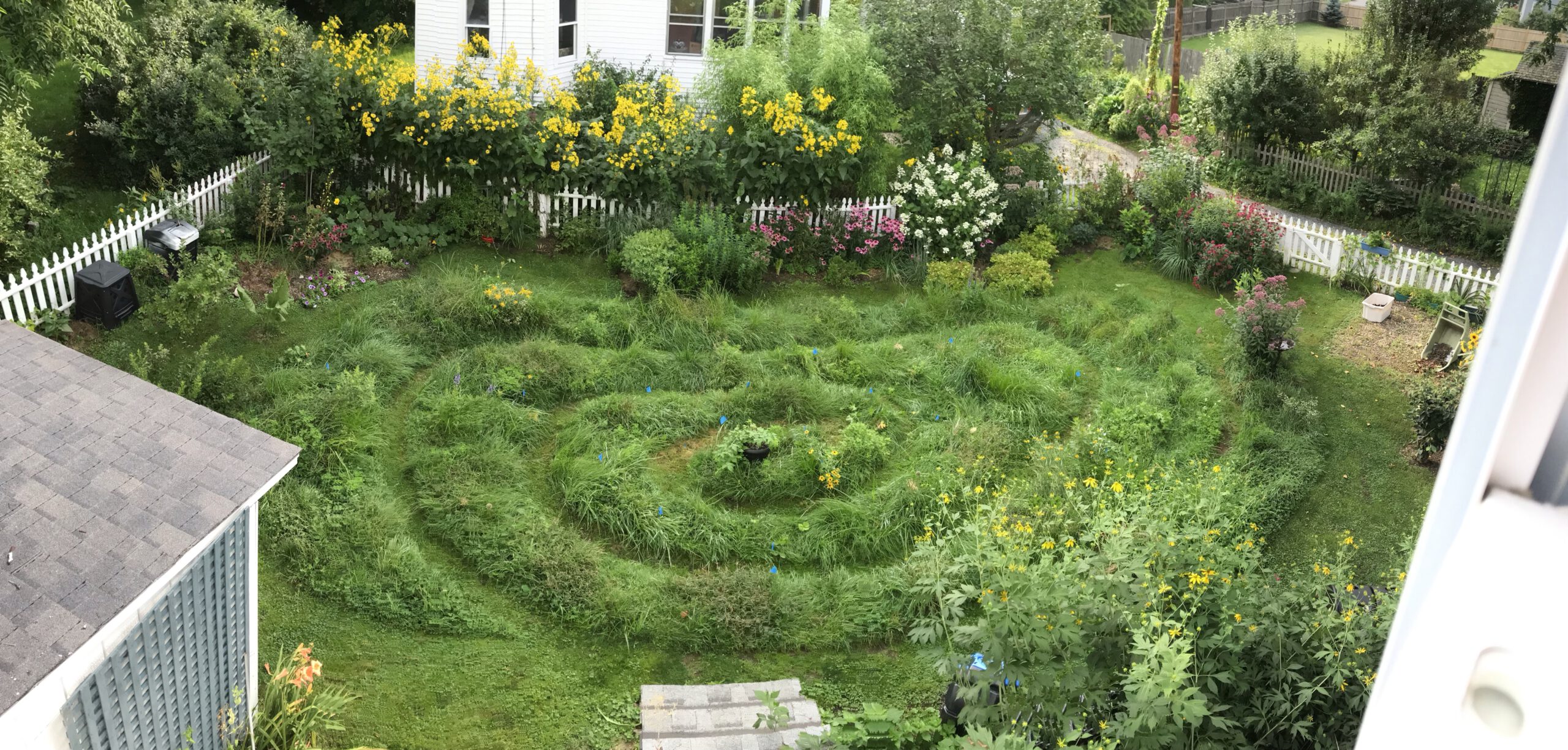I have stopped mowing a spiral-shaped strip of my fenced-in lawn. I started for “No Mow May” and just kept going. In addition to less time spent mowing, these are the changes I’ve noticed through August:
More bugs; in particular grasshoppers. Remember them? It wasn’t until I started seeing them again that I realized I had not seen them for some time! How crazy. “Grasshoppers are beneficial and play a critical role in the environment by making it a more efficient place for plants and other animals to thrive. They facilitate a natural balance in the decomposing and regrowth process of plants. One of the ways they are able to do so is by consuming enough plant life or certain parts of plants that help maintain overgrowth in the area.”
More birds in the trees surrounding the spiral, and three frogs! Could this be due to the additional insects? Well, research shows that “(i)f you stop mowing your whole lawn or part of it, for a month or a season, you can create a busy wildlife habitat…Lawns are a home for beetles, other insects and worms, and they attract birds…that feed on the invertebrates hidden below.”
Even more eloquent: “An unmowed area is habitat for a bouquet of life. The roots of the plants are engaged in a vibrant microbial dance in their subterranean substrate where millions of organisms are doing their busy work of decompositional nutrient recycling. Small insects such as ants, aphids, beetles, and spiders busily scurry up the plant stalks. Preying upon those small insects are a myriad of predators–larger insects, birds, frogs, lizards, and small mammals… All these complex interactions can be found in one small patch of unmowed space.”
More flowers. No purchases needed! Indeed, these new flowers are appearing on their own. “Plants already present will have the chance to grow and bloom. Clover seeds may already be in your lawn as they used to be included in packets of lawn seed. Other seeds get blown in or dropped by birds. You might also expect to see Speedwell, Selfheal, Buttercups…” I now have several of these flowers in addition to Black-eyed Susan, Goldenrod, Lobelia and the lovely daisies of Fleabane. I wake up each morning going out to discover which new plants and flowers will pop up next. Keep in mind, “(y)ou don’t have to stop mowing completely. Some species, such as daisy and bird’s foot trefoil, are adapted to growing in shorter swards. Cutting flowers from these plants once a month stimulates them to produce more blooms.”
More pollinators on all of the various flowers that have sprung up in the grassy,spiral strip. This is not only simple but also great news for bees. The timing could not be more important. “In New York state, the American bumblebee has declined an estimated 99% from historic levels, according to the New York Department of Environmental Conservation. In Illinois, where the bee once represented 1 in 4 bumblebee sightings, it has disappeared from the northern part of the state and, overall, is down an estimated 74% since 2004.” While I am choosing to continue my “No Mow” approach for my spiral through the entire growing season, research does indeed show that even “No Mow May lawns have higher pollinator richness and abundances: An engaged community provides floral resources for pollinators.” I am choosing to extend the benefits of less time spent mowing and increased diversity all the way through to the fall.
Fireflies! I had never seen them here before. They were, selfishly, the main reason I had to mow less. “If you want to attract more fireflies… stop mowing as frequently. Fireflies are attracted to high grasses and shrubbery, and they rest on tall blades of grass during the day.” “Fireflies are dying out because people are destroying their habitats” This is the least I can do to preserve a treasured part of my childhood summers!
Less allergy-inducing plants. Really? This seems counter-intuitive but “researchers have found that reducing the intensity of lawn mowing in urban spaces leads to increased biodiversity, economic savings and reduced presence of allergy-triggering weeds.” Researcher Chris Watson explained that “Having a more rapid reproduction than other species, ragweed is able to colonise disturbances caused by intense mowing…Certain lawn invaders, such as ragweed, can be decreased simply through reducing lawn mowing frequency.” My daughter has seasonal allergies. I’ll take any improvement we can get, especially when it requires less effort!
“But what about the ticks??” you say. Well the good news is that while “(t)he potential for long grass to harbour ticks and rodents is a common concern… Dr Chris Watson sa(ys that) there is little evidence to support this. “The presence of ticks are more strongly related to host populations, like deer, than type of vegetation.”
All of this is not only exciting but free! “The United States has approximately 50 million acres of residential landscapes. Simply reducing the amount of your lawn mowing bodes extremely well for our communities’ ecosystem diversity and health. “Mowing urban lawns less intensely increases biodiversity, saves money and reduces pests…(In fact,) even a modest reduction in lawn mowing frequency can bring a host of environmental benefits: increased pollinators, increased plant diversity and reduced greenhouse gas emissions. At the same time, a longer, healthier lawn makes it more resistant to pests, weeds, and drought events.” said Dr Chris Watson, lead author of the study.”
Full disclosure: I was not able to tolerate stopping mowing my entire yard. It was just too messy, too much for my aesthetic preferences. However, this silly spiral has been key to making environmental stewardship at my home easy and fun. Maybe you’ll find a creative way to mow less too? If so, be sure to let me know. Let’s share every bit of increased ecological diversity combined with financial savings we can!
Sources:
https://www.sacnaturecenter.net/visit-us/nature-blog/news.html?NewsID=69976
https://www.nhm.ac.uk/discover/how-to-grow-a-better-lawn-for-wildlife.html
https://content.yardmap.org/learn/must-we-mow/
https://www.nhm.ac.uk/discover/how-to-grow-a-better-lawn-for-wildlife.html
https://www.gardensillustrated.com/feature/lawn-mowing-when-flowers-may/
https://biologicaldiversity.org/w/news/press-releases/endangered-species-act-protection-sought-american-bumblebee-2021-02-01/
https://www.ncbi.nlm.nih.gov/pmc/articles/PMC7518183/
https://www.americannativeplants.com/4-ways-to-attract-lightning-bugs-to-your-yard/
https://www.usatoday.com/story/news/nation/2019/08/01/firefly-decline-insects-decline-development-destroys-habitat/1886909001/
https://www.sciencedaily.com/releases/2019/12/191219074744.htm
https://content.yardmap.org/explore/the-average-american-yard/

